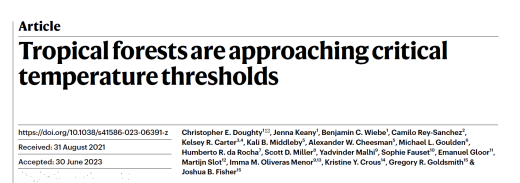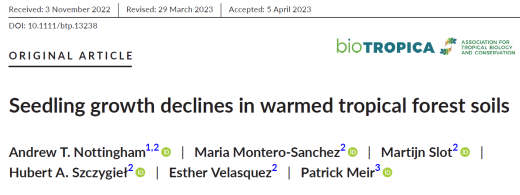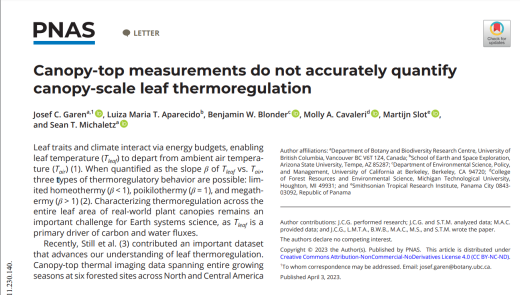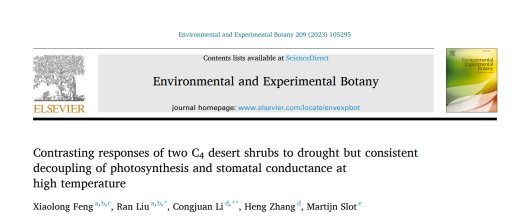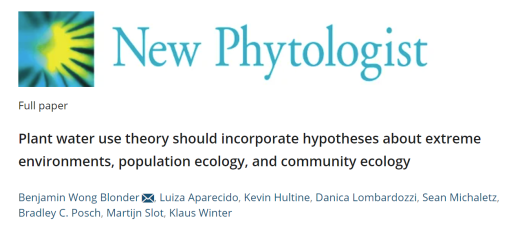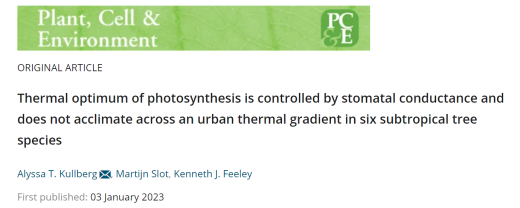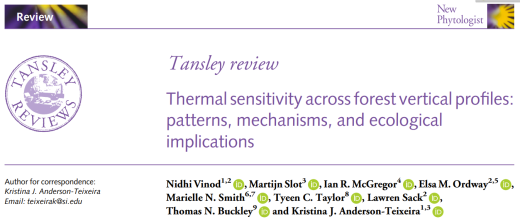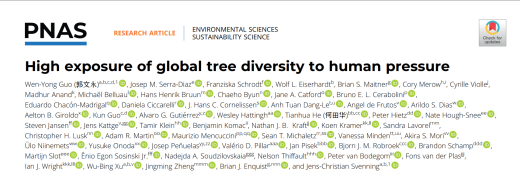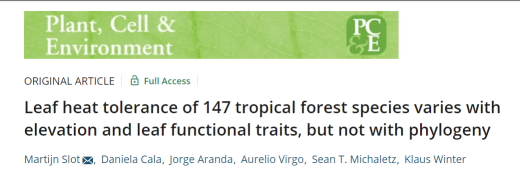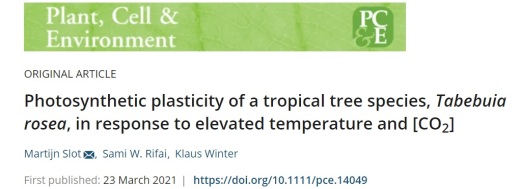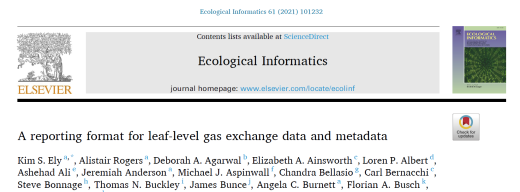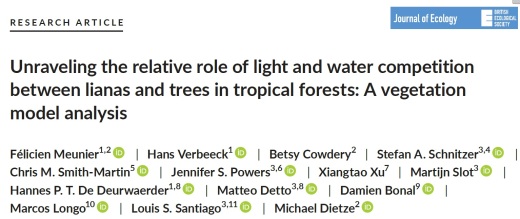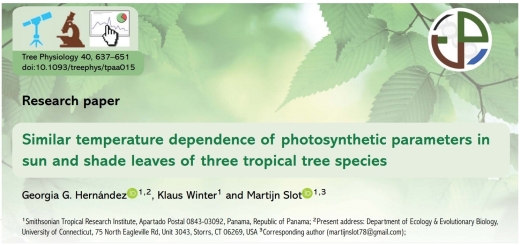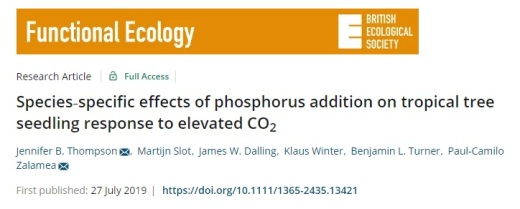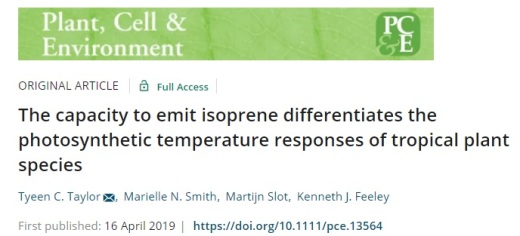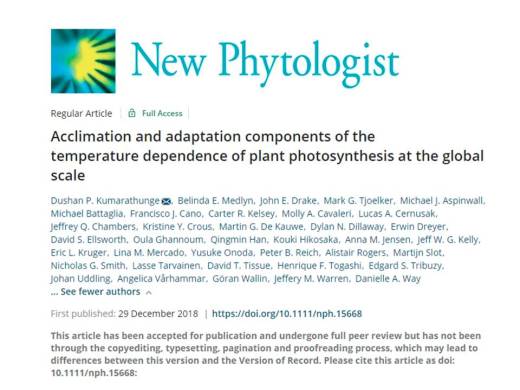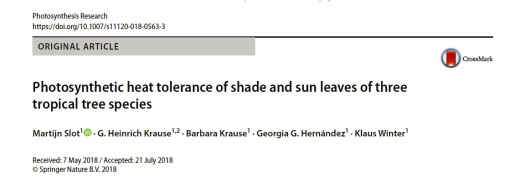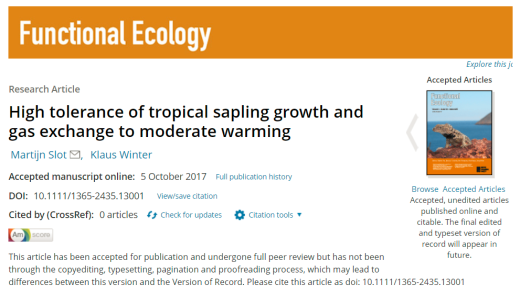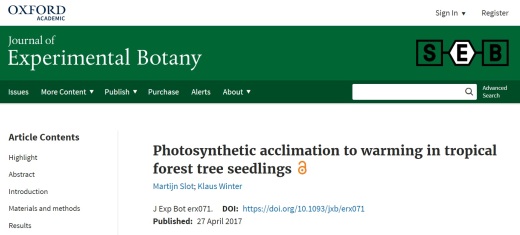Martijn Slot
Research biologist
Smithsonian Tropical Research Institute
Box 0843-00153, Republic of Panama
martijnslot78[at]gmail[dot]comScroll down for new papers!
.
My research focuses on understanding the effects of climate change on terrestrial plants. Climate change can have major consequences for plant performance, yet our understanding of the mechanisms by which plants may adjust to environmental changes is limited. I study plant growth, physiology and reproduction with the aim of understanding the adaptation and acclimation of plants to their environment. Results from this research improve our ability to predict plant responses to environmental change, in terms of the size and direction of the carbon fluxes between the terrestrial biosphere and the atmosphere, and in terms of shifts in competitive strength among different species within a community in a changing environment.
Click on the images below to get the PDFs or download them in the Publications tab.
New papers in 2024
In this paper we show that stomatal response to rising VPD drives the decrease of photosynthesis between the apparent optimum temperature of ~30C and the VPD-corrected optimum temperature of ~34C. So it is the indirect effect of warming, through changes in VPD, that is the primary driver of decreasing photosynthesis at high temperature, not a direct effect on the photosynthetic capacity.
Divergences in stem and leaf traits between lianas and co-existing trees in a subtropical montane forest. In this study, led by Xiao-Long Bai, functional traits of trees and lianas are compared in a subtropical montane forest in southern China, and the key finding is that they are distinctly different, and stem and leaf traits that correlate in trees, do not correlate in lianas. A fun collaboration with the lab of Jiao-Lin Zhang, who was my office mate when I spent 3 months at XTBG 20 years ago (I still haven’t been back since)
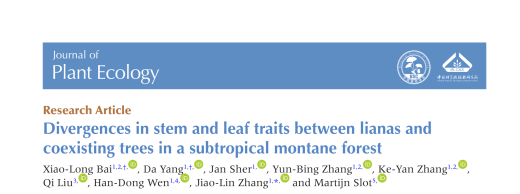
New papers in 2023
How close are tropical forest canopies to reaching critical temperatures (Tcrit) that lead to irreversible damage and leaf death? Here, we use leaf-level temperature measurements, leaf warming experiments, and remote sensing data to determine the leaf temperature distribution and proportion of leaves likely to exceed Tcrit presently, and under simulated climate warming,
Using a full soil profile warming experiment on Barro Colorado Island, we asked how soil temperature affects seedling growth and photosynthesis for species that are known to be nitrogen fixers and species that are non-fixers. The results suggest that soil warming has a negative effect of growth and photosynthesis, particularly for nitrogen fixing species, suggesting that the process of nitrogen fixation is negatively impacted by elevated soil temperatures in the tropics.
In this paper, we show that phylogenetic and functional turnover of tree species is lower, and ‘nestedness’ is higher than random expectations in regions that experienced strong temperature changes since the Last Glacial Maximum. So, species from specific lineages or with specific traits are more likely to have experienced glaciation-driven extinction or time lags in postglacial recolonization. These results suggest that current climate change is likely to have strong and long-lasting effects on future tree assemblages.
A commentary with data suggesting that leaf thermoregulation might be particularly common in subcanopy layers, even if the sun-exposed upper canopy typically exceeds air temperatures.
Paper from an experiment in the Taklamakan desert that Xiaolong Feng led. Above 40-45C, stomatal conductance of two C4 shrubs increased, while photosynthesis decreased. This decoupling of water use & carbon fixation was even found under drought.
In this conceptual paper we survey a range of scenarios that could affect optimal water use and stomatal regulation that is not captured by current plant water use theory that conceptualizes water loss and hydraulic failure as costs of carbon gain. Some scenarios have growing empirical support; others are fairly speculative. The goal of this viewpoint is to get people thinking about where the optimization models might fail.
New paper, finding no evidence that trees across Miami’s urban heat island can/do thermally acclimate their photosynthesis. This is part of Alyssa’s PhD research
In this Tansley Review, led by Nidhi Vinod and Kristina Anderson-Teixeira, we review the biophysical vertical gradients in forest canopies, the gradients in leaf temperature, associated leaf traits, leaf gas exchange, and sensitivity to temperature, and the consequences for ecology and ecosystem science.
_
New papers in 2022
n this paper that builds on Freya Newman’s thesis project, we evaluated the temperature-independent changes in nighttime respiration, using data collected in Australia, Brazil, Colombia, Denmark, Panama and the UK. That turns out to be quite significant. We present a new equation to address this, and ran simulations with an ecosystem model using the new formulation for respiration. Given the magnitude of the annual respiration flux, accurate representation of both the temperature-dependent and the temperature independent changes over short timespans, is critically important.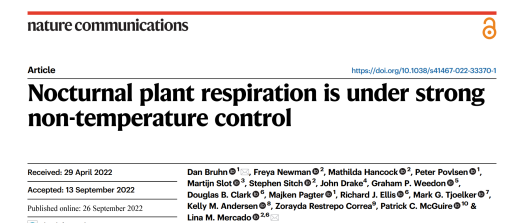
Using species range estimates for >45,000 tree species, this study reports that on average 50.2% of a tree species’ range occurs in 110-km grid cells without any protected areas, with > 6,375 small-range tree species entirely unprotected. 83% of tree species are exposed human pressure across their range. There is a strong need to protect tree diversity via increased coverage of protected areas through well-targeted conservation actions and integration of tree diversity into restoration efforts in human-dominated landscapes.
In this book chapter we review the effects of climate change on reproductive phenology, seeds, and seedling performance in wet tropical forests.
New papers in 2021
During droughts plants run the risk of dying from desiccation. We show that tropical trees differ significantly in how much water they lose through their leaf cuticles and how temperature influences this water loss, independent of whether species occur in wet or dry tropical forests. Species that readily lose water during drought are thus at greater risk under predicted future climates.
New paper led by Bruno Pinho found that climate instability in northern tropical forests promotes dominance of soft-wooded, small-seeded generalist tree species. In more stable equatorial zones, hard-woods and large-seeds thrive.
To determine the variation in leaf heat tolerance and investigate what explains such variation, we measured heat tolerance traits for 147 plant species of tropical lowland and pre-montane forests in Panama. Variation in heat tolerance was related to elevation and leaf traits associated with leaf thermoregulation and leaf construction costs, but not to phylogenetic relatedness of the species
In this new paper we report acclimation of photosynthetic parameters to warming and elevated CO2, using saplings of tropical tree species Tabebuia rosea. We measured plants grown at +4°C & 800 ppm CO2, and then switched conditions to look at short-term acclimation of fully-developed leaves. The optimum temperatures for photosynthetic parameters adjusted to growth temperature, particularly in leaves developed under treatment conditions. A cool feature of our analyses is the Bayesian approach to curve fitting and parameter estimation.
Reporting leaf level gas exchange data, if made public at all, lacks consistency, and without the right data or metadata, future use of those data can be compromised. In this paper lead by Kim Ely and Alistair Rogers, with input from 60 or so co-authors, a reporting format is presented that, when followed, will maximize the utility of the data for future modeling, meta-analysis, and reassessment efforts
This study asks whether axes of leaf trait variation as known mostly from global and other large scale analyses, can also be found locally, in the absence of environmental variation. Combining analyses with trait data from the TRY database with field observations and experiments in Argentina, this study concludes that indeed, even in homogeneous environmental conditions patterns in leaf trait variation emerge to generate an acquisitive-conservative axis.
New papers in 2020
Lianas play an important part in tropical forests, competing with trees for access to light and water, while utilizing trees for structural support. In this model study, the importance of light competition and water competition between trees and lianas is evaluated in two tropical forests.
How do we treat the shade fraction of multi-layered canopies in carbon flux models? Do shade leaves respond to temperature as sun leaves do? Georgia Hernández, who worked with me as an intern in 2017-2018, got a new paper accepted in Tree Physiology in which she shows that shade leaves behave very similarly to sun leaves, making life easier for modelers!
As plants are exposed to increasingly high temperatures, their heat tolerance will become important for survival. In this study species differences in heat tolerance were tested in a hot and rapidly warming tropical forest in Brazil. Heat tolerance was among the highest recorded for tropical species, yet the temperature at which the decline in photosystem II (PSII) activity starts is already exceeded during heat waves. Another interesting finding is that in species in which PSII activity does not decline until very high temperature, the decline is very steep, whereas in species in which PSII activity starts to decline at lower temperatures, the decline is more gradual.
The TRY trait database has been growing continuously since its conception, and the terms of used have changed. The database is now open access, and this new paper describes the dataset, its development and the gaps.
New papers in 2019
In temperate ecosystems plant growth at elevated CO2 eventually becomes limited by the availability of nitrogen. Tropical ecosystems are thought to be phosphorus limited instead, but while some species exclusively grow in phosphorus rich soils, others grow predominantly on phosphorus poor soils. Here we tested how phosphorus availability affected the growth response to elevated CO2 of species that differ in soil phosphorus “preference”
Small differences in performance at high temperature may be critically important for community dynamics in a warming world. In this paper, led by Tyeen Taylor, we show that isoprene-emitting species have higher maximum temperature for photosynthesis than non-emitting species, supporting experimental studies suggesting that isoprene-emission is a key adaptation to high temperatures.
Differences in the temperature response of photosynthesis can be explained by acclimation and adaptation; this paper shows–among other things–that acclimation is more important than adaptation in explaining global patterns in temperature optima
New papers in 2018
For every sun leaf there are ~five shade leaves in a tropical forest: can we assume that shade leaves have the same heat tolerance as sun leaves, or are they acclimated to cooler conditions? We found a small, but significant difference in two of the three species, with shade leaves having lower tolerance to heat (early online).
Do increases in temperature during the day or during the night influence growth of tropical saplings? We expected they would, but we found that the species we studied displayed considerable physiological plasticity in response to warming and increases in average night- or day temperatures did not significantly reduce plant growth in any species. Nonetheless, with rising mean temperatures the fluctuations around the mean may cause extreme conditions that will be detrimental to the performance of tropical species.
New papers in 2017
In this paper on temperature effects on photosynthesis of tropical trees, we show temperature responses of Vcmax, Jmax and stomatal conductance for four species. Stomatal conductance peaks at much lower temperatures than the biochemical parameters and our analyses suggest that the decrease in stomatal conductance is the main driver in the decrease in net photosynthesis above current ambient temperatures.
Our paper on acclimation of photosynthesis to (elevated) temperature in tropical tree seedlings shows consistent increases in the optimum temperature for photosynthesis, but no increase in the high-temperature carbon compensation point, leading to narrower temperature response curves for plants grown at elevated temperatures. See the Highlight for this paper by Dusenge & Way here.
This paper, led by Zhang-Hong Tan, uses Eddy Co-variance data to analyze stand-level photosynthesis in relation to temperature across seven tropical forest sites. The temperature optimum of stand-level carbon uptake scales with site temperature. Above the optimum temperature decreases in stomatal conductance drive the decrease in photosynthesis.
A survey of temperature responses of photosynthesis across 42 tree and liana species in two lowland tropical forests, which shows a tendency for convergence of TOpt—the optimum temperature for net photosynthesis—across ecologically divergent co-occurring species, with site-specific temperature optima very similar to mean maximum daytime temperatures. 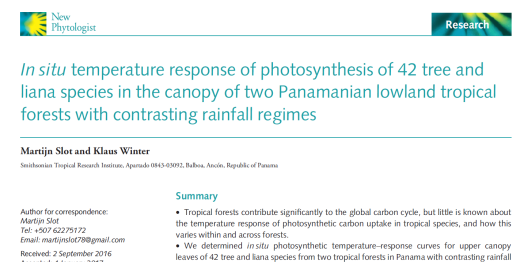
Links



